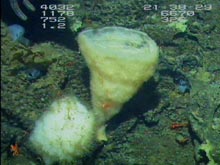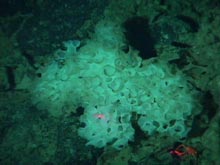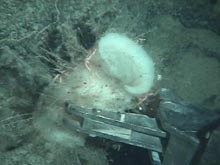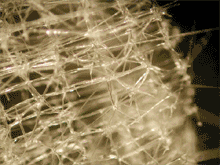
Glass sponges grow in many shapes and sizes in the deep ocean. Pictured here are a vase sponge and a ball-shaped species. Note the small red shrimp on the vase sponge. Click image for larger view.
View a slide show of some of the sponges of the Alaska Seamounts. ![]() Click image to view the slide show.
Click image to view the slide show.
The Glass House: Sponges of the Alaska Seamounts
August 11-12, 2004
George P. Schmahl
Sanctuary Manager
Flower Garden Banks National Marine Sanctuary
![]() Deep-sea corals are not the only habitat formers on the seamounts. (mp4, 10.3 MB)
Deep-sea corals are not the only habitat formers on the seamounts. (mp4, 10.3 MB)
![]() The "condominiums of the deep": deep-sea corals provide habitat for a large variety of organisms. (mp4, 3.7 MB)
The "condominiums of the deep": deep-sea corals provide habitat for a large variety of organisms. (mp4, 3.7 MB)
Sponges are an obvious and important component of the sea floor animal community in many marine habitats, including the seamounts of the Gulf of Alaska. In every dive conducted so far, scientists in the deep submergence vehicle (DSV) Alvin have documented sponges. Next to the deep-water corals, they are probably the most common invertebrate group attached to the substrate. Like corals, they provide important habitat for a variety of mobile marine creatures, such as brittle stars, crabs, crinoids (feather stars), and shrimp. While much attention is given to the study of deep-sea corals, much less is known about the role that sponges play in deep-sea biological communities.
What is a sponge? Sponges are one of the most primitive forms of multicellular animals. They are one of the groups of “sessile” invertebrates, which mean they are firmly attached to the sea floor (with a few bizarre exceptions) for their entire adult life. They survive by pumping water through their porous bodies to extract very small food particles and dissolved substances. Although primitive, sponges have been a very successful animal group. There are over 7,000 known species of sponges, but scientists agree that there are probably thousands more species which have yet to be discovered.
Like all sessile invertebrates, sponges can neither run nor hide from predators. Therefore, over the millions of years of their existence, sponges have developed novel ways to keep other organisms from eating them. Sponges produce a wide range of interesting chemicals within their tissues that help defend against predation. Recently, scientists have discovered that some of these chemicals are also useful for human purposes, including the treatment of diseases like cancer. Like deep-water corals, sponges are threatened because of habitat destruction from indiscriminate trawling and other human activities.
Sponges exist in a variety of growth forms. Some grow as thin encrustations on rocks; others are amorphous blobs. Many sponges form complex and beautiful structures, resulting in colorful tubes, vases, baskets, and barrels. Some sponges, like those found in Antarctica, grow as large as a Mini Cooper! To support these growth forms, sponges contain internal skeletons made of mineral substances or protein fibers. Most sponges utilize small mineral “bones” made of silicon dioxide (silica), called “spicules.” The glass-like spicules come in a variety of shapes and sizes, and they can form complex structures that give the sponge its shape and support.
Because many sponge species have spicules of a unique size and shape, taxonomists (scientists who identify and categorize living organisms) use them to differentiate species of sponge. A distinctive set of spicules of a specific size and shape that sets them apart from all other species. Spicules exist in a host of bizarre shapes, like spears, clubs, stars, hooks, and horns, but individual spicules are usually tiny -- less than a millimeter in length -- and must be viewed under a microscope.

The glass sponge, Farrea occa, from about 750 m depth at Welker Seamount. This sponge forms colonies up to several meters in diameter that provide important habitat for a variety of other species. Click image for larger view.

The science party nicknamed this unique vase-like sponge "Bill Clinton."Click image for larger view.
The most common sponges we have encountered on this mission are representatives of a group called the glass sponges, or hexactinellids, that is common only in the deep ocean. Unlike most sponges, glass sponges produce extremely large spicules that fuse together in beautiful patterns to form a “glass house”; a complex skeleton that will often remain intact even after the sponge itself dies. The most famous glass sponge is a species of Euplectella, known as the “Venus flower basket,” which builds its skeleton in a way that entraps a certain species of shrimp inside.
My favorite sponge so far is a unique vase-like species that was collected August 3 on Dive #4027 at 2,345 m (approximately 7,738 ft) at Denson Seamount. It stood about 8-10 in off the sea floor, but instead of being attached to a rock, this sponge had formed a root-like structure out of over-sized spicules (several inches in length) in order to anchor into the soft substrate. In the lab on deck, when the sponge was viewed with the root mass pointing upwards, someone remarked that the sponge had hair like Bill Clinton. The name stuck.
Like most glass sponges, "Bill Clinton" had very distinctive spicules. One type of spicule looked like a spiked club with five sharp prongs at the other end -- a form that sponge taxonomists refer to as a “pinular hexactin.” This sponge also contained a very small hook-like spicule known as an “amphidisc,” which tells us that it is within the order of glass sponges known as Amphidiscosida. With further study, we hope to narrow its identity down to the species level -- and give it a proper scientific name.
Sign up for the Ocean Explorer E-mail Update List.

























